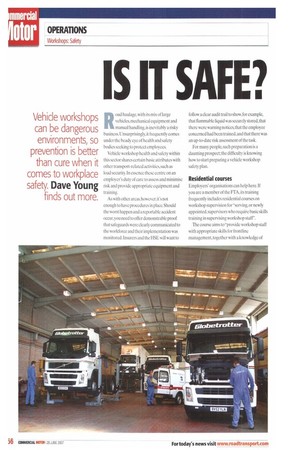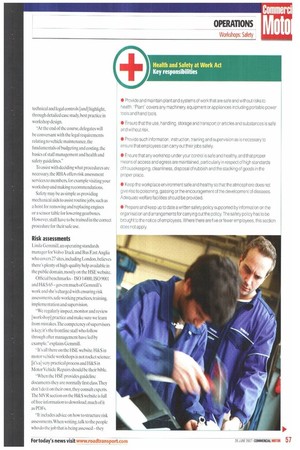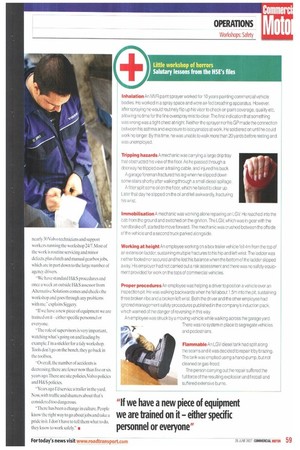S IT SAFE?
Page 56

Page 57

Page 58

Page 59

If you've noticed an error in this article please click here to report it so we can fix it.
Vehicle workshops can be dangerous environments, so prevention is better than cure when ft comes to workplace
safety. Dave Young
finds out more.
Road haulage, with its mix of large vehicles, mechanical equipment and manual handling, is inevitably a risky business. Unsurprisingly, it frequently comes under the beady eye of health and safety bodies seeking to protect employees.
Vehicle workshop health and safety within this sector shares certain basic attributes with other transport-related activities, such as load security. In essence these centre on an employer's duty of care to assess and minimise risk and provide appropriate equipment and training.
As with other areas, however,it's not enough to have procedures in place. Should the worst happen and a reportable accident occur, you need to offer demonstrable proof that safeguards were clearly communicated to the workforce and their implementation was monitored. Insurers and the HSE will want to follow a clear audit trail to show, for example, that flammable liquid was securely stored,that there were warning notices, that the employee concerned had been trained,and that there was an up-to-date risk assessment of the task.
For many people, such preparation is a daunting prospect; the difficulty is knowing how to start preparing a vehicle workshop safety plan.
Residential courses
Employers' organisations can help here. If you area member of the FTA, its training frequently includes residential courses on workshop supervision for "serving, or newly appointed, supervisors who require basic skills training in supervising workshop staff".
The course aims to"provide workshop staff with appropriate skills for frontline management, together with a knowledge of technical and legal controls land] highlight, through detailed case study, best practice in workshop design.
"At the end of the course, delegates will be conversant with the legal requirements relating to vehicle maintenance, the fundamentals of budgeting and costing, the basics of staff management and health and safety guidelines."
To assist with deciding what procedures arc necessary, the RHA offers risk assessment services to members, for example visiting your workshop and making recommendations.
Safety may be as simple as providing mechanical aids to assist routine jobs, such as a hoist for removing and replacing engines or a scissor table for lowering gearboxes. However, staff have to be trained in the correct procedure for their safe use.
Risk assessments
Linda Genunill, an operating standards manager for Volvo Truck and Bus East Anglia who covers 27 sites, including London, believes there's plenty of high-quality help available in the public domain, mostly on the HSE website.
Official benchmarks— ISO 14000,1SO 9001 and H&S 65 —govern much of Gem mill's work and she's charged with ensuring risk assessments, safe working practices, training, implementation and supervision.
"We regularly inspect, monitor and review [workshop] practice and make sure we learn from mistakes. The competency of supervisors is key; it's the frontline staff who follow through after management have led by example," explains Gemmill.
-It's all there on the HSE website. H&S in motor vehicle workshops is not rocket science: [it's a] very practical process and H&S in Motor Vehicle Repairs should be their bible.
-When the HSE provides guideline documents they are normally first class.They don't do it on their own, they consult experts. The MVR section on the H&S website is full of free information to download.much of it as PDFs.
"It includes advice on how to structure risk assessments, When writing, talk to the people who do the job that is being assessed—they know where the danger points are. Use their expertise; the manager provides the structure, while the workshop staff give the detailed knowledge."
Part of Gemmill's job is to help set up dealer operating standards, stating what procedures they must follow, and to that end she and her colleagues have created 27 concise working practice safety documents—for such tasks as uncoupling trailers,tilting cabs and working at height-They're just a simple A4 sheet with bullet points and the supervisors go through the processes with the technicians," says Gemmill.
"It's important to know which accidents are by law reportable —failure of lifting equipment, for example.
"We try to learn from accidents, it's not about blaming. Investigations show incidents usually come from a failure in management systems rather than. say an individual's failure to wear PPE.
"We're not complacent, but we're working towards zero accidents. In our industry it's been seen as normal to bash thumbs in the past, but the tide is turning.
"If we look at our accident statistics from three or four years ago and compare them to the present, accidents are decreasing.
"We need to be aware that although manual-handling injuries are decreasing, things such as back problems are cumulative and tend to manifest in older workers.This can be where training is important — if there's a special tool for the job, use it.
-Gradually the [workshop] culture is changing. Slips, bumps and falls are a problem. People never fail down the pit. they fall down oil spilt on the pit steps."
We have a co-ordinator on each site, someone at grass roots level, perhaps a technician or parts person, and give them practical support to make regular checks and keep records, [but] this doesn't mean the final responsibility is taken away from managers. The routine inspections by the co-ordinators take in workshop equipment and pressure hoses.
"I can say with confidence from talking to outside consultants within the marketplace we are at the top. but of course this means continuous improvement and taking into account legislation changes.
Guidance documents
Some procedures applicable to workshops, such as working at height, also apply to other industry sectors.The USE site has a specific 10minute talk on this which can be downloaded.
-There are guidance documents for employees and employers:a lot of it you can find in-house. [Using this information] there's no need to get someone else in, they are researching and updating the information all the time and—to those who complain about the cost of training and implementing procedures—a lot of it is either free or cheap," concludes Gemmill.
-The HSE site is well worth looking at, if only to dispel the popular myth that because it's got a high flash point you can cut up diesel tanks with impunity."
Gemmill's colleague Kevin Siggery is one of the people who is implementing her H&S policies day to day.He'sVolvo's operations point manager at a massive supermarket RDC near the M25 with a purpose-built new workshop and maintenance responsibility for 780 trucks and trailers on two sites.
The vehicles, mainly Volvo FM units. are on R&M leases and maintained by a staff of nearly 30 Volvo technicians and support workers running the workshop 24/7. Most of the work is routine servicing and minor defects, plus clutch and manual gearbox jobs, which are in part down to the large number of agency drivers.
We have standard H&S procedures and once a week an outside H&S assessor from Alternative Solutions comes and checks the workshop and goes through any problems with me," explains Siggery.
If we have a new piece of equipment we are trained on it either specific personnel or everyone.
"The role of supervisors is very important, watching what's going on and leading by example. I'm a stickler for a tidy workshop. Tools don't go on the bench, they go back in the toolbox.
"Overall,the number of accidents is decreasing: there are fewer now than five or six years ago.There are site policies,Volvo policies and H&S policies.
"Years ago I'd service a trailer in the yard. Now, with traffic and shunters about that's considered too dangerous.
"There has been a change in culture. People know the right way to go about jobs and take a pride in it. I don't have to tell them what to do, they know to work safely."






























































































































































































